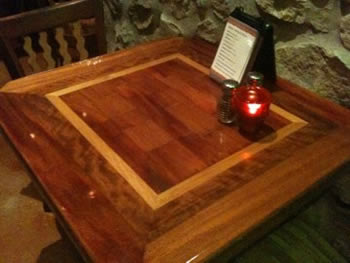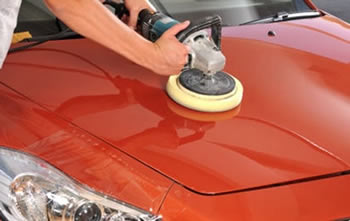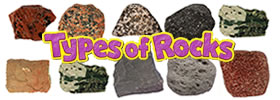Difference between Teflon Coating and Polymer Coating
Key Difference: Polymer Coating or Polymeric coating refers to coatings or paints that are made with polymers that provide protection from corrosion. Teflon Coating is a type of Polymer Coating that is made from polytetrafluoroethylene (PTFE), which is sold under the brand name "Teflon."

Polymer Coating or Polymeric coating refers to coatings or paints that are made with polymers that provide superior adherence and protection from corrosion. For a polymeric coating, an elastomer or other polymeric material is applied on to a supporting substrate, i.e. a surface that accepts or supports the polymer.
Depending on the type of polymer used, the polymer coating can have many benefits, such as anti-rust, anti-corrosion, resistance to heat and damage, etc. Polymer Coatings can be applied to metals, ceramics as well as synthetic materials. Polymer Coatings are very resistant to heat in particular; hence they are often used in food production, such as coating for containers, multi-head scales, frying pans, etc. In addition, they are also commonly used on farm equipment and industrial products requiring good corrosion protection, on conveyor equipment, aircraft, radomes, tugboats, road-building machinery, and motorcycle parts, as well as on railroad hopper cars, and linings used in sandblasting cabinets and slurry pipes. Polymer coating made from Nylon 11 provides attractive appearance as well as protection from chemicals, abrasion, and impact, and hence is commonly used for aesthetic appeal.
There are many different types of polymers. Polymer Coating can be made from natural and synthetic rubber, urethane, polyvinyl chloride, acrylic, epoxy, silicone, phenolic resins, nitrocellulose, and many more. Polymeric coatings designed for corrosion protection are usually tougher and are applied in heavier films than are appearance coatings.

A specific type of Polymer Coating is made out of Polytetrafluoroethylene (PTFE). This coating is sold under the brand name Teflon. Hence, Teflon-coating is nothing more than a specific type of Polymer Coating.
Polytetrafluoroethylene (PTFE) was accidentally discovered in 1938 by Roy Plunkett while he was working in New Jersey for DuPont. Since then Teflon has been used in a variety of uses, ranging from industrial parts or frying pans. This is due to the variety of its benefits such as high melting temperature, high strength, toughness and self-lubrication, flexibility, third-lowest coefficient of friction, non-stick, anti-rust, anti-corrosion, heat and damage resistant, hydrophobic, etc.
Comparison between Teflon Coating and Polymer Coating:
|
|
Teflon Coating |
Polymer Coating |
|
Description |
A type of Polymer Coating made out of Polytetrafluoroethylene (PTFE) and sold under the brand name Teflon. |
Polymer Coating or Polymeric coating refers to coatings or paints that are made with polymers that provide superior adherence and protection from corrosion. |
|
Made of |
Polytetrafluoroethylene (PTFE) |
Various including natural and synthetic rubber, urethane, polyvinyl chloride, acrylic, epoxy, silicone, phenolic resins, nitrocellulose, etc. |
|
Benefits |
High melting temperature, high strength, toughness and self-lubrication, good flexibility, third-lowest coefficient of friction, non-stick, anti-rust, anti-corrosion, heat and damage resistant, hydrophobic, etc. |
Anti-rust, anti-corrosion, resistance to heat and damage, hydrophobic, etc. mainly depends on the type of polymer used to make the coating. |
|
Uses |
Teflon is best known for its use in coating non-stick frying pans and other cookware. It is also used for wiring in aerospace and computer applications (e.g. hookup wire, coaxial cables); as an insulator in cables and connector assemblies and as a material for printed circuit boards used at microwave frequencies; and for applications where sliding action of parts is needed: plain bearings, gears, slide plates, etc. It is also used for various niche applications such as in outdoor apparel, to make it waterproof and stain-proof; as a film interface patch for sports and medical applications; in pyrotechnic compositions as an oxidizer with powdered metals such as aluminium and magnesium; in optical radiometry; in certain types of hardened, armor-piercing bullets; in laboratory environments for lining containers, as a coating for magnetic stirrers, and as tubing for highly corrosive chemicals; gas-gas heat exchangers; as a thread seal tape in plumbing applications, industrial air filters; as grafts that can be used to bypass stenotic arteries; bicycle lubricants; dental fillings; etc. |
Often used in food production, such as coating for containers, multi-head scales, frying pans, etc. Also used for farm equipment and industrial products, conveyor equipment, aircraft, radomes, tugboats, road-building machinery, and motorcycle parts, as well as on railroad hopper cars, and linings used in sandblasting cabinets and slurry pipes. |
Image Courtesy: delviesplastics.com
Image Courtesy: groupon.co.in









Add new comment